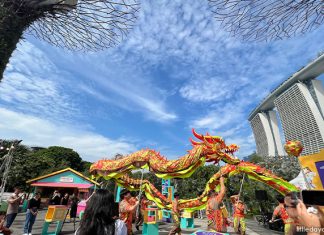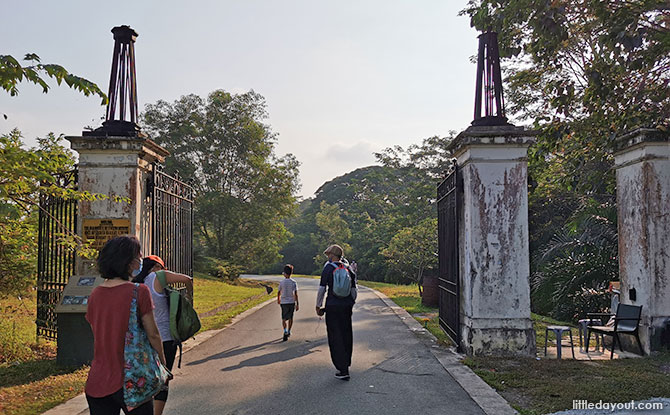
Bukit Brown Cemetery is no ordinary walk in the park, but it’s well worth a visit especially on a guided tour. The “living museum” allows visitors to see, feel, touch the “artefacts”, with stories behind each person, carving, tile, statue and even bullet hole.
The first thought of entering a cemetery for most might be – spirits and spookiness. Bringing kids along on a cemetery walk might be taboo. On the contrary, it is better to see death as a reality and natural occurrence rather than shun it altogether. We seized the opportunity to join in another of National Heritage Board’s Bukit Brown World War II tour and were fascinated by how much gravestones can teach and impart.
The Significance of Bukit Brown during World War II
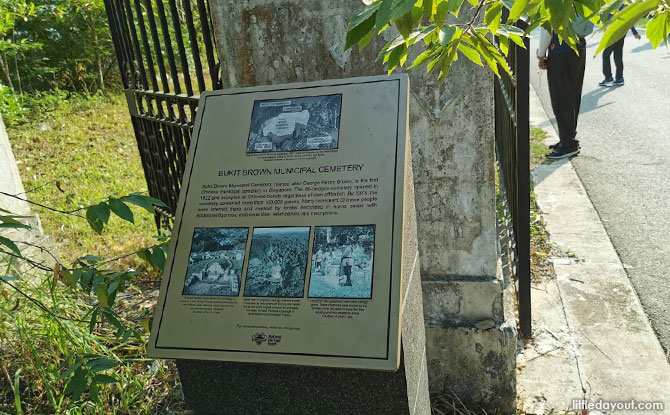
Bukit Brown is a large piece of land which belonged to George Henry Brown who used it for planting of crops like nutmeg and coffee. After his passing, the land transferred hands and eventually was bought by the Ong clan and the British government as burial grounds. It is now a closed cemetery with no burials since 1973.
FREE FOR LITTLE DAY OUT PARENTS: Sign Up for a Free Trial with ACT 3 Academy to Find Out If Drama Classes are Right for Your Child
What has Bukit Brown got to do with World War II? Plenty. It was the last battleground before the fall of Singapore as MacRitchie Reservoir, Singapore’s water source, and Command House were nearby. This resulted in many soldiers dying at Bukit Brown defending Singapore.
There are also graves of war heros, heroines, collaborators, civilians buried at Bukit Brown during and after the war. Often, their graves tell of stories that the textbooks don’t. At our first walk, we were honoured to have Fabian Tee, a volunteer “Brownie” regale us with tales of Bukit Brown. This time, it was Peter Park, the “rojak librarian”, an avid birder, tomb hunter and advocate of Bukit Brown who took us on a tour from Hill 2 to Hill 4 on a balmy Saturday morning.
Many of us would have passed Bukit Brown which lies just beneath the Lornie Flyover. The flyover had resulted in many graves exhumed and relocated to other places. “Brownies” hold regular tours to highlight the significance of Bukit Brown in relation to Singapore’s history and heritage.
Our Pioneers at Bukit Brown Cemetery
Truth be told, most of us would likely know someone who is related to those buried at Bukit Brown Cemetery. Significant figures include the grandparents of our present and former leaders like Tony Tan, Lee Kuan Yew and even Crazy Rich Asian Kevin Kwan.
Some of us may even have relatives laid to rest in those same grounds. These connects us to the past as the graves have stories untold, which are precious not just to memorialise important figures but to learn more about our own history.
There are close to 100,000 graves at Bukit Brown and it is believed to be one of the largest Chinese graveyards outside China. We visited some of the graves on Hills 1, 2 and 3 belonging to people who had varied roles in WWII or perished during the war.
Our guides patiently walked us through the wordings on the gravestones, interpreting information such as date of passing according to various calendars, symbols, carvings, tiles and the number of wives.
Most Straits-born Chinese, with Peranakan heritage, usually had bilingual graves in English and Mandarin. This reflected their roles in the colonial era, often working and socialising with the British. Some of these graves have beautiful Peranakan tiles decorating them.
We also learnt the difference between Teochew and Hokkien graves, and how money divided those who had larger graves on higher ground, and those who had small graves laid at the Pauper section which was the lower section of Bukit Brown.
Later i learnt that a prominent ancestor, more specifically my husband’s great great great grandfather was buried in Bukit Brown. He also has a road named after him, made great contributions to the Chinese community and education sector and equally colourful family dynamics.
Prominent Graves at Bukit Brown
Wong Chin Yoke
At Wong Chin Yoke’s family burial plot is where the tallest Sikh guards of Bukit Brown still stand. Wong Chin Yoke was a detective constable, in charge of suppressing subversive organisations in the Special Branch. In 1937, he received the Coronation Medal.
Before the fall of Singapore, he went to Indonesia to start an anti-Japanese resistance movement. Unforutunately he was betrayed, tortured and killed by the Japanese in 1943. 11 years later, he was buried with full police honours.
Stories of local heroes like Wong Chin Yoke come alive at the tours of Bukit Brown. While we may not read about him in textbooks, visiting his grave remind us of the roles our pioneers played during significant moments such as the war.
Lim Chong Pang
Mr Lim Chong Pang, perhaps known for the Chong Pang area in the Northern part of the Singapore, is the second son of Lim Nee Soon a prominent rubber and miller merchant. His grave was on a family plot with graves of his mother, wife and other relations.
While he survived the war, part of his family did not. Before the fall of Singapore, Lim Chong Pang and his family boarded a ship with other evacuees bound for Sumatra. However the Japanese caught wind of the ships escaping Singapore and bombed them. while Mr Lim Chong Pang and some family members were rescued, his mother Mrs Lim Nee Soon was lost at sea. Her body, like many others, were never found hence the empty grave still stands at Bukit Brown.
Mr Lim Chong Pang was a reluctant supporter of the Japanese who was released from captivity on the promise of supporting the war efforts. After the Japanese surrendered, he was imprisoned for collaborating with the Japanese but later released and exonerated.
He lived till 1956. A year later, West Hill Estate was renamed Chong Pang Village and the road as Chong Pang Road. The village was part of Mr Lim Chong Pang’s rubber estate.
Biggest Grave: Ong Sam Leong
The largest grave at Bukit Brown belongs to Mr Ong Sam Leong. Mr Ong was an enterprising businessman who provided indentured labourers for the mining of phosphate to Christmas Island. He owned substantial land and properties, as expansive as his tomb which is a grand sight to behold.
It is at the highest point of Bukit Brown with two stone lions and sikh guards watching over the tomb. The ground is lined with colourful “Peranakan” tiles. There was also a huge moat which had fish in it. Local village children used to swim in it. One can also see the 24 complete carvings of filial piety at the tomb.
Grave of Dr Lee Choo Neo
We heard the story of Singapore’s first lady doctor, Dr Lee Choo Neo, a lesser known relation of PM Lee Hsien Loong. Clearly a trailblazer, instead of staying home and cooking like many Peranakan ladies were expected, she went to schools which are also known as prominent girls’ schools today.
Dr Lee, like many of the Chinese in Singapore, felt compelled to support China’s war against Japan. She even contributed two war planes to the British war efforts.
Such fundraising efforts by the Chinese in Malaya fuelled the fierce resistance of the Chinese against the Japanese in China. When the Japanese conquered Singapore, they were bent on punishing those who had supported China’s war efforts. In the ensuing Sook Ching operation, it is estimated that close to 70,000 Malayan Chinese lost their lives.
Dr Lee, unlike other Chinese who were killed during the war for their anti-Japanese stance, was spared. Before the war, she had a close Japanese neighbour and her family took good care of his young son. In a twist of fate, during the war, her Japanese neighbour’s son, now older, was a soldier in the army. However, he protected her throughout the Japanese Occupation and Dr Lee was even able to continue her medical practice.
She certainly should be better known today as a role model who made great contributions to society.
Grave of Tan Ean Kiam / Tan Ean Teck
As an operational cemetery during the war, Bukit Brown saw the burials of those who died during the war and suspected mass graves of soldiers who were hastily buried.
Among the graves we saw were that of patriots like Tan Ean Kiam, Tan Ean Teck as well as Tay Koh Yat. The three Tan brothers are the ancestors of renowned author of Crazy Rich Asians – Kevin Kwan. Their prominence in the plantation, real estate and banking sector also meant big efforts in rallying support as Overseas Chinese.
During the war, they were coerced to be collaborators with the Japanese. Trapped between a rock and a hard place, they had to help the Japanese financially. The patriots died a year apart during the war – one probably due to the guilt from working with the Japanese, while the other was killed by the pro-Communists in Johor while he was surveying land in Johor for plantation use.
Grave of Soh Koon Eng
Aside from heroes, we also saw graves of the man in the street. One was a 19-year-old Soh Koon Eng who died from a bombing raid. Her niece had shared how she had cried out in pain before dying, as she was hit by splinters from the ancestral altar table.
Such precious memories can only be captured through retelling of stories and wartime stories are especially poignant because of the pain and suffering experienced.
Other Things to See at Bukit Brown
Bukit Brown Memorial – Sounds of the Earth
The memorial is made up of about 80 unclaimed tombstones, decorative tiles and building bricks. Shaped in a elliptical design, the artefacts were painstakingly arranged to form an interactive space where visitors can hear the echo of their own voices.
The installation hope to spur visitors to think about the tension between development and heritage preservation in Singapore. Located right next to the Lornie Highway, one can hear the sounds of the busy traffic overhead juxtaposed with the sounds of nature on the other side.
The construction of Lornie Highway resulted in the exhumation of about 4,000 graves. The installation is made out of the unclaimed artefacts that remain. We could also see the gravestones of different nationalities, stories of those departed indicative of the past engraved on the stones.
Avatar Trees
Avid hikers might hike at Bukit Brown to see the “Avatar Trees”. The ficus trees grow up to 30 meters tall and the spectacular sight remind many of a surreal landscape like in the movie “Avatar”.
Our Thoughts from the Walk at Bukit Brown Cemetery
Graves, as silent as they be, speak volumes about history and heritage. The insights gleaned from the graves about the war showed how unbearable it could have been. Many had the same tragic end, while others endured shame, guilt and trauma for surviving it. There are no winners in war.
While we did not encounter any spirits, we definitely felt the passion and enthusiasm of our volunteer guide whose group “All Things Bukit Brown” conducts walks almost every month.
The keen sense to preserve this prime area through educating others about the rich history of the silent folks at rest is evident and compelled us to want to do the same. We loved the peace and tranquility of Bukit Brown. The area was not just rich in heritage but biodiversity. We hope it remains as it is for a long time, especially for future generations to visit.
We left with a lingering message by Peter – to love and honour our parents and elders while they are alive, rather than only when they are dead. Seeing how the graves were faithfully cleaned by descendants, while others remained dilapidated or overtaken by nature is striking. Yet the act of piety extends beyond how well-kept a grave ought to be – this was also a lesson from the famous Thai movie “How to Make Millions before Grandma Dies”.
How to Join Bukit Brown Tours
There are various themed walks by the “Brownies” from All Things Bukit Brown, not just war related but walks about Gangsters as well as Crazy Rich Asians. Get notified here if you would like to join in a walk.





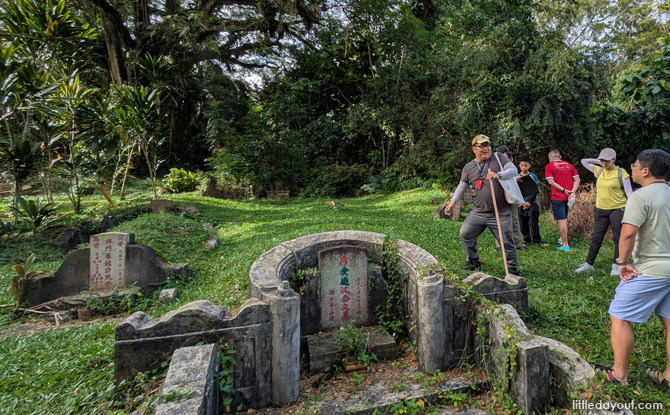
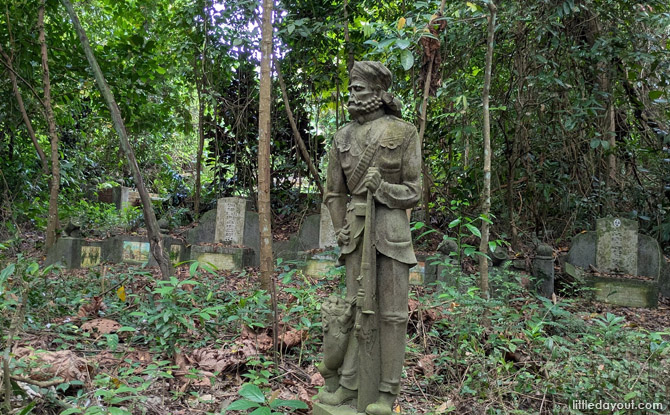
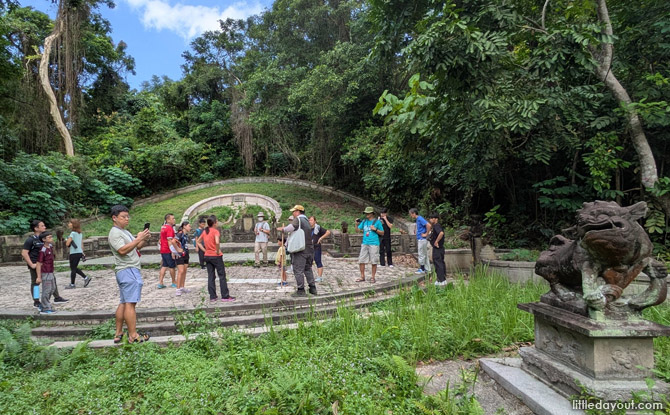
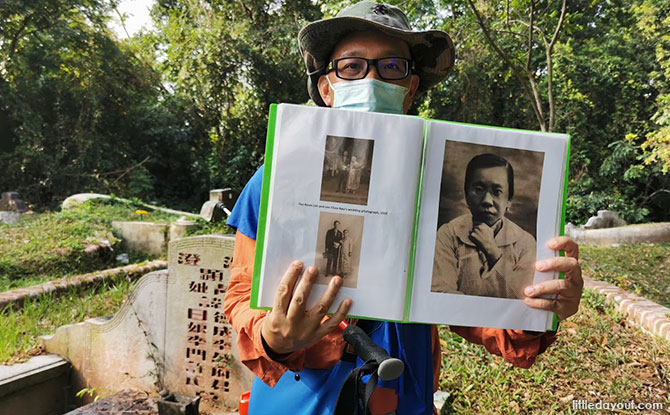
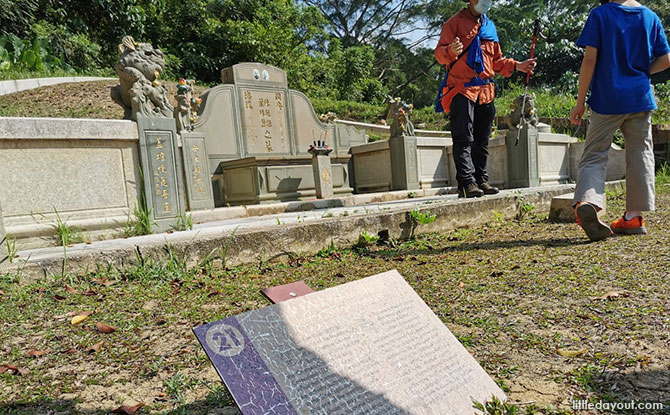
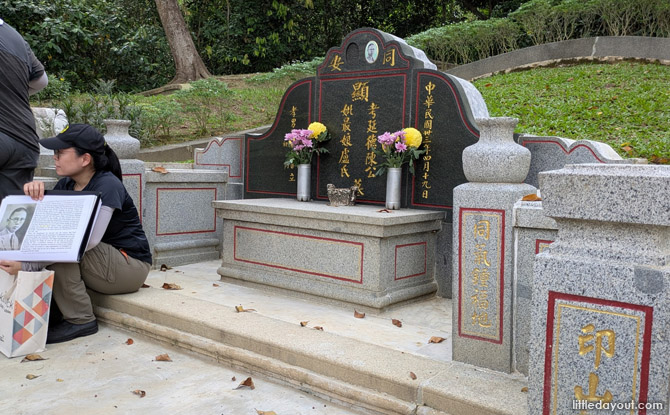

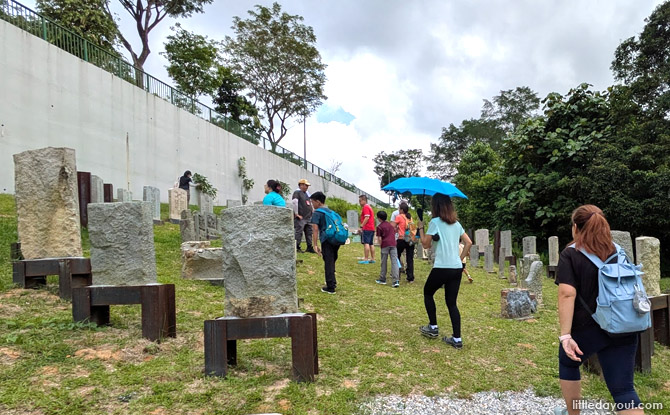
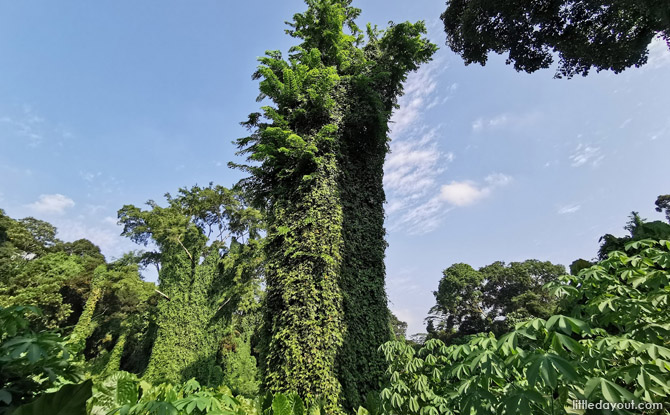
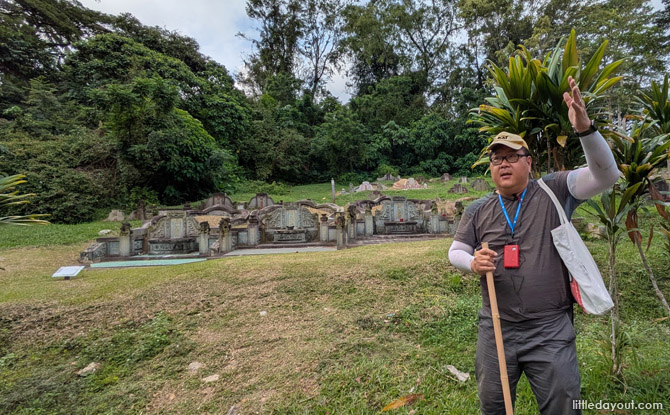
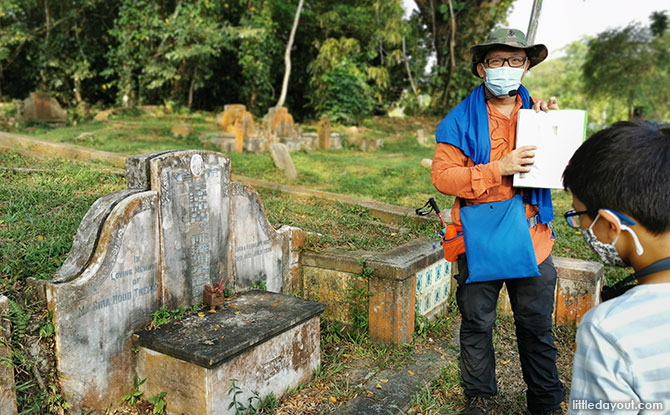



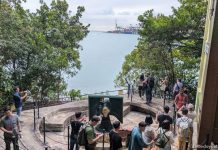
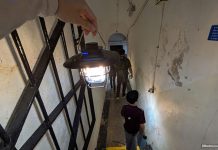


![36 Best Museums For Kids In Singapore: A Curated List For Curious Explorers [Updated 2025] 30+ Best Museums For Kids In Singapore: A Curated List For Curious Explorers](https://www.littledayout.com/wp-content/uploads/08-childrens-museum-singapore-218x150.jpg)
![Chinatown Heritage Centre Reopens: Go On A Journey Through Time At 48 Pagoda Street [Updated 2025] Chinatown Heritage Centre: A Journey Through Time](https://www.littledayout.com/wp-content/uploads/chinatown-heritage-centre-00-218x150.jpg)
